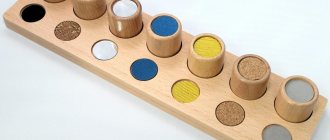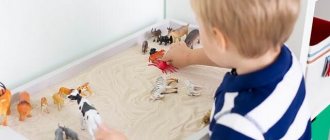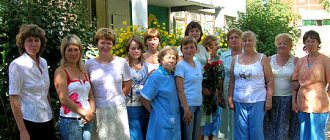Articulation of the sound Zh
Phoneme Ж is a hard and voiced consonant. Its articulation is similar to the pronunciation of Ш, but with tension of the vocal cords, that is, with the participation of the voice.
This is how the articulatory formation of the sound Z occurs:
- the lips are slightly pulled forward and rounded;
- the tongue rises to the upper palate and comes into contact with its posterior surface;
- the tip of the tongue, directed upward, is located behind the upper incisors;
- The sides of the tongue are in contact with the molars.
Why doesn't the child pronounce the letter "w"?
The sound “zh” is very difficult to pronounce. Therefore, there are often cases when this defect in a child remains neglected. Incorrect pronunciation of hissing and whistling sounds (for example, “zh” and “sh”) at the age of 5-6 years is a very common phenomenon, which is called functional dyslalia.
As a rule, it does not go away on its own. You need to consult a speech therapist. The reasons can be a variety of factors, both psychological or social, and physiological, for example, heredity, developmental disorders, pedagogical neglect, etc.
For any speech defect in children, it is necessary to contact specialists if the parents were unable to eliminate it themselves, because in the future it will be much more difficult to treat the neglected effect. You need to be patient, consult with a speech therapist, and your baby will definitely pronounce the letter “w”.
Causes of defective pronunciation
There are several factors that prevent you from mastering the pronunciation of the sound Z:
- anatomically incorrect frenulum of the tongue;
- a high and deformed hard palate that cannot accommodate the tongue;
- defects of the jaws and dentition, cleft palate;
- open, protruding bite.
In these cases, the help of an orthodontist or surgeon is required. But more often, the reason for incorrect pronunciation of F is a lack of understanding of what articulation should be, or the child copying the distorted speech of people around him. In these cases, correction of incorrect pronunciation is possible using speech therapy methods.
Reasons for incorrect sound pronunciation
There are several reasons why a baby may not be able to make sounds:
- Short frenulum of the tongue - you will have to cut it, because it does not allow the tongue to rise up, which is necessary for the pronunciation of sibilants;
- High narrow hard palate;
- Abnormal structure of teeth and jaws - gaps between teeth, cleft palate and upper lip;
- Features of the bite: open, deep with protrusion.
In these cases, consultation with an orthodontist is necessary. But in most cases, children simply do not understand how to pronounce the sound correctly or copy the speech of other children, for example in kindergarten. In this case, speech therapy exercises “w” and gymnastics - articulation and breathing - will help.
Staging the sound Z in stages for a speech therapist
Speech therapy work includes 3 stages of adjusting sound pronunciation with gradual complication of tasks:
- staging - learning correct articulation, pronouncing an isolated sound;
- automation - sound reproduction in syllables, words, phrases;
- differentiation - auditory perception of a phoneme with the ability to distinguish it from similar sounds.
Speech hearing
Correct speech of a child is achieved through speech hearing. To pronounce sounds correctly, the child must clearly perceive them by ear.
Determine the location of sounds in a word: at the beginning, middle or end of the word. Hear whether a given sound is hissing or not.
Distinguish sounds against the background of similar sounds:
- In an isolated position
- In syllables
- In words
Expert opinion
Margarita Sergeevna S.
Speech pathologist and speech pathologist with 15 years of experience working in various speech correction centers with children of different ages.
With dysarthria, the production and automation of hissing sounds becomes more complicated and requires more time and individual training.
Articulation gymnastics for the sound Zh
First, the speech therapist teaches the preschooler to correctly place the articulatory organs when pronouncing the sound Z. The most common and effective method is imitation: the adult shows movements with the lips and tongue, the child repeats. It is advisable to place a mirror in front of the preschooler. Then the child will see how correctly he repeats the movements of the speech therapist.
Young children may find it difficult to hold their tongue in a certain position. Then, in the first lessons, the speech therapist uses probes—fixing and massage devices.
Articulation gymnastics is the first stage of each speech therapy session. Here are the optimal exercises for setting the F:
- “Damn”: the mouth is slightly open, the relaxed tongue is spread out on the lower lip, the upper row of teeth is visible. Duration - 10 seconds.
- “Yummy”: the tip of the tongue is relaxed, licks the lower and then the upper lip in a circular motion.
- “Cup”: the tongue is arched into a cup shape, the sides are in contact with the upper molars.
- “Glue the toffee”: the relaxed tip of the tongue lies on the lower lip, and a piece of toffee or other chewing candy should be placed on it. Then the child must stick this candy to the front of the roof of the mouth with his tongue. At the same time, he should not move his lower jaw, and his mouth should be open no more than 2 cm.
- “Mushroom”: the lips are stretched in a smile, the teeth are visible, the mouth is slightly open, the relaxed tongue is pressed with its entire surface to the palate. Then you need to open your mouth wide so that your tongue looks like a mushroom cap and its frenulum looks like a stem.
- “Accordion”: the mouth is slightly open, the lips are stretched in a smile, the tongue is pressed to the palate. Holding your tongue in its original position, you need to open and close your mouth, fixing it in one position or another for 3-10 minutes. The frenulum of the tongue will relax and tighten, like the bellows of a musical instrument.
Breathing exercises
When the articulation of the sound Ж is correct, an air flow flows outward along the tongue. When articulation is defective, this flow is absent. The goal of breathing exercises is to teach a preschooler how to breathe correctly when pronouncing the sound Zh.
When a preschooler performs breathing exercises, the speech therapist must monitor his body movements. It is important that the child’s shoulders do not move, and that the chest rises calmly and low when inhaling. Relaxed and short inhalations should go through the mouth, and exhalations should be calm and leisurely.
Recommended breathing exercises when placing F:
- Blow off a paper butterfly lying on your palm. The further she flies, the better.
- Smile, arching your tongue upward and hiding its tip behind the lower row of teeth. Exhale.
- Exhaling deeply and briefly, extinguish the candle flame, while saying a long “fu”.
- Smile with your mouth slightly open, cup your tongue, and press the relaxed tip to your upper lip. The child should, exhaling air through the hole between the cupped tongue and lip, blow off a piece of cotton wool placed on the nose.
- Bring a bottle with a narrow neck to your lower lip and blow into it to make a sound.
Exercises for making the sound Z
The phoneme Ж is easy to place from Z, Ш or R. But this is relevant if the preschooler pronounces the listed sounds correctly. Here are the relevant exercises:
- Setting from R. The child pronounces the syllable “ra”, at this moment the speech therapist, using a probe, eliminates the vibration generated when pronouncing R. The sound changes to Zh. The exercise is repeated until the preschooler learns to pronounce the syllable “zha”.
- Production from Z. The preschooler pronounces “for” in a drawn-out manner. At the same time, the speech therapist lifts the tip of the tongue to the palate with a probe and fixes it behind the upper incisors.
- Setting from Sh. The simplest option that does not require a probe. The speech therapist simply explains to the child how to connect the vocal cords when pronouncing Sh.
Setting the sound Z for individual lessons
The performance of F in a playful form is divided into 3 stages. The first stage is a demonstration of how the articulatory organs should be positioned when pronouncing a sound.
Second phase
This stage includes articulation and breathing exercises, followed by practicing the isolated sound Z. The following exercises are used:
- “Beetles”: the speech therapist shows the preschooler an image of flying bugs and asks them to remember how insects buzz over summer grasses. Children make a sound.
- “Bees”: the game is played in a group, some of the children become bees, the other part become flowers. The teacher invites the students to show how bees circle over flowers and collect nectar. Children pretending to be bees run around their friends, buzzing as they do so.
- “Web”: a group game, some children stand in a circle, but do not hold hands - this is a web, other children pretend to be flies. The second ones run between their comrades, run inside the circle, run out, while buzzing. At the teacher’s command, children standing in a circle grab each other’s hands. Children who do not have time to run out of the circle are flies caught in a web. They also stand in a circle, that is, the web becomes larger. The game continues until the last fly remains. This player becomes the winner.
Third stage
At this stage, the pronunciation of Ж in words and sentences is practiced. It can be started only after the preschooler learns to clearly pronounce an isolated sound.
For classes you need paired pictures depicting objects and scenes. The object images show objects whose names contain the sound Zh. The main thing is that it should not come at the end of a word or before a voiceless consonant phoneme. And plot images should represent the plots with which the objects depicted in other pictures are connected. For example, for the picture “fireman” the pair will be an image of a burning building.
With these pictures, children perform the following tasks:
- The teacher shows an object image. Children name the depicted object.
- The teacher shows plot pictures and asks what object is missing from them. Children answer, look for the corresponding object picture.
- The teacher asks why this or that object is needed. The students answer in detail. For example, “a knife is needed to cut food into pieces.”
Incorrect pronunciation of sound: types of sibilant sigmatism
Sometimes parents of a child who has problems with sound pronunciation turn to a speech therapist late for help. Or they even think that the baby has no problems with speech, due to the fact that they do not always know how this or that sound should be reproduced correctly. Each sound has its own articulatory position. By ear, it may seem that the child seems to pronounce it (doesn’t miss it or replace it, just “F” is heard), but at the same time he doesn’t always articulate it correctly.
The work is carried out individually, depending on the characteristics of the violation. There are several types of hissing sigmatism, characterized by incorrect position of the organs of the speech apparatus:
- Lower (the sound is softened).
- Rear-lingual (in this case, the position of the articulatory organs is as with the sounds G, X; this leads to the fact that the sound Z is pronounced noisily).
- Buccal (in this case, the tongue is motionless, the cheeks are puffed out, the teeth are closed, and a dull, booming sound is formed).
Tasks for automating sound
Automation also takes place in stages, it involves consolidating correct articulation in syllables, then in words and sentences.
Automation of the sound Ж in syllables
The child consolidates the pronunciation of Zh in the syllables “zha”, “zhi”, “zho”, “zhe”, “zhu”. Next, pronunciation in a syllable series is used. For example: “zhu-zhu-zhu”, “zha-zha-zha”. Then there are rows with different syllables, for example: “zho-zhe-zhu”, “zha-zho-zhi”. To make things more complicated, a fourth syllable is added, for example: “zho-zha-zhi-zhu.”
Automation of the sound Ж in words
The speech therapist invites the preschooler to pronounce words that include the above syllables, as well as combinations of consonants “zhg”, “zhg”, “zhb”, “zhn” and others. First comes the automation of words in which the specified syllables are the first (jelly, heat, giraffe, reaper), then the last (luggage, leather, fire, friendship) and, finally, in the middle (pajamas, glutton, cake).
Clear automation is important in words that contain consonants: clothes, scissors, wait, curd. It is also important to work on words that have two phonemes F: ground beetle, zhizha, thirst, buzz.
Automation of the sound Ж in sentences
The child repeats after the speech therapist phrases where both words contain the sound Z. For example: a beetle is buzzing, yellow pajamas, a burn is burning, a leather jacket, a fat pie.
Next comes automation in multi-word sentences. The child reads them:
- a fat toad lives in a puddle;
- red saffron mushrooms grew along the path;
- Zhora eats gooseberries, and Zhenya eats blackberries;
- the husband works as an engineer, and the wife is an artist.
Pronunciation of pure sayings like these is used:
- zha-zha-zha - the toad drove away the snake;
- zhu-zhu-zhu - I’m not friends with beetles;
- zhi-zhi-zhi - tell me about the animals;
- Same, same, same - the saffron milk cap rides on a hedgehog;
- jo-jo-jo - I feel fresh with ice cream.
The child learns and recites from memory a short poem in which words with the J sound are often used.







